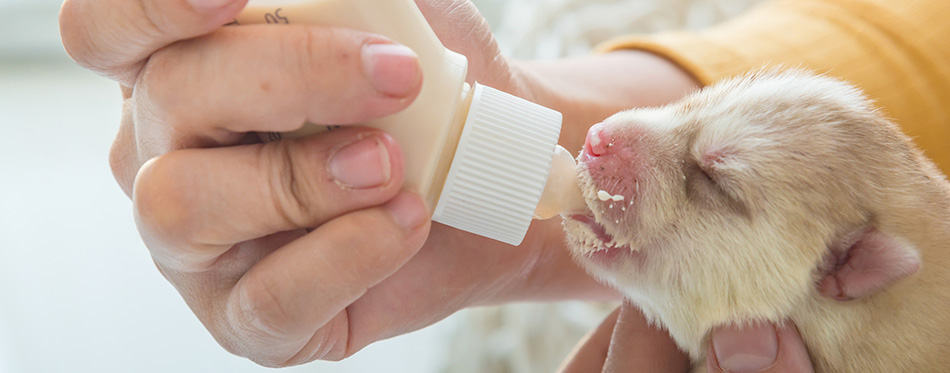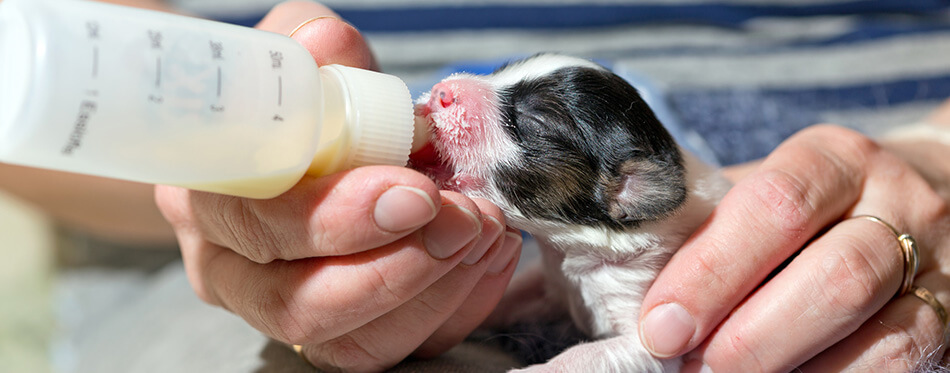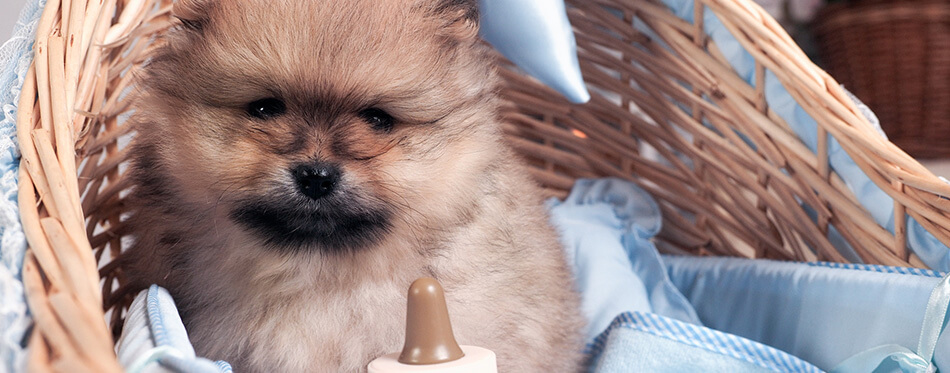Bottle feeding orphaned puppies may appear to be a daunting responsibility. However, puppies need fed to ensure their survival, so the necessity of the task certainly supersedes the worry you’re bound to feel about feeding puppies.
Stumbling across this article constitutes the first step towards successfully feeding your pups. Comprising of nine sections, we’ve outlined the most pertinent questions individuals have about feeding, the weaning process, milk replacement, and many more. We’re positive that by the end, you’ll feel as confident as a veterinarian when it comes to pet care!
What Should You Feed Newborn Puppies?
There is a colossal difference between what you should feed newborn puppies compared to the means you have available. Undoubtedly, what newborn puppies should be fed is their mother’s milk. This fact is undisputed and not even intense marketing campaigns led by puppy milk replacers have succeeded in convincing consumers otherwise. Nutrient-rich fluid colostrum, produced by female mammals straight after giving birth, is pivotal in providing pups with the nutrients they require to grow. As colostrum contains large amounts of complement components that function as natural anti-microbial agents, any infections that are likely to arise in a puppy’s gastrointestinal tract are prevented or treated. In other words, the multiple regenerative effects in relation to all structural body cells that colostrum provides are simply incredible.
Referring back to the problem at large, however, is that many newborn puppies don’t have the luxury of receiving a mother dog’s milk. Orphaned puppies aren’t necessarily the only pups who won’t have mother’s milk available for them either. If a mother feels as though there isn’t enough milk to go around a large litter, if she’s dehydrated or stressed, or if she has infected glands, you may have to find other means to feed her newborn puppies – and fast. And the solution to your puppy feeding problems comes in the form of commercial puppy formula. So, what are your options?

Different Types Of Puppy Formula
To outline the options you have available, we’ve outlined the most popular types of formula below: powdered puppy and canned puppy formula.
- Powdered Puppy Formula
As one of the most popular puppy milk replacers, powdered puppy formula is mostly tolerated by puppies’ digestive systems. Brands work hard to ensure their puppy milk replacer is both palatable and digestible for growing canines by adding vegetable oil into the mixture. To make up for the lack of essential vitamins and minerals puppies are losing from their absence of mother’s milk, brands fortify these powdered formulas with colostrum.
Bear in mind that once the powder has been reconstituted, any leftover formula should be discarded after a period of 24 hours. Although it may be tempting to hold onto it – after all, the formula certainly won’t go to waste – resist temptation. It’s not uncommon for puppies not to survive, so proper hygiene is essential for keeping them safe.
As well as colostrum, look out for the powdered newborn puppy milk that contains goats’ milk. Packed full of an abundance of vitamins such as B, E, K, and D, goats’ milk should facilitate digestion for young puppies.
- Canned Puppy Formula
Unlike powdered puppy formulas, canned puppy formulas are already pre-mixed. Although this means they must be refrigerated from the time of purchase, they’re undoubtedly more convenient for when you’ve got newborn puppies to feed. For many, however, the price for convenience just isn’t worth it, as canned puppies are more expensive than powdered formulas.
Whatever kind of puppy formula you decide to opt for, our review containing both powdered and liquid forms of formula will help you get started.
Bottle Feeding Vs. Syringe Feeding
- Bottle Feeding
Bottle feeding is a feeding strategy with the objective to allow puppies to suckle from the rubber nipple. The good news is that bottles with rubber nipples are readily available, either commercially at pet stores or can be obtained through veterinary hospitals.
Pro: When compared to syringe feeding, bottle feeding is a far more natural feeding method for puppies. As it’s more natural, this means that the amount of mess one makes when bottle feeding puppy formula is minimal compared to syringe feeding. This will certainly saves you a lot of time clearing up after feeding. And when you have inquisitive puppies who are only weeks old running around, you’ll need all the time you can get!
Con: One of its disadvantages is that bottle feeding does more time, approximately ten to fifteen minutes to be exact, although you should never cut a larger hole in the rubber nipple’s tip to facilitate faster meals. This could cause your puppy to have trouble breathing and choking or aspiration may ensue.
- Syringe Feeding
Syringe feeding differs from bottle feeding in that food is introduced into a puppy’s mouth to encourage them to swallow it spontaneously.. To achieve this, the plunger of the syringe should be drawn back with the nozzle in the pet formula to suck up the milk replacement. Then, the syringe tip should be placed at the corner of a puppy’s mouth. Once in position, you must push down the plunger, bit by bit, so small amounts of food are deposited onto their tongue.
Pro: Syringe feeding is often a life savior for owners whose puppy doesn’t have a strong enough suck to feed from a bottle. In comparison to bottle feeding, it takes much less time which is wonderful for individuals who have a whole litter of puppies to look after! Generally, a twenty milliliter syringe filled with milk replacer should take between three to five minutes to feed to a pup. Head over to our review of puppy food for more options.
Con: The major con of syringe feeding is that the process is undoubtedly more complicated than bottle feeding. And its complexity means that a lot more could go wrong using this method in comparison to bottle feeding. As your puppy won’t have any control over how much milk they receive, you must ensure that you only drip small amounts of milk on their tongue and should never force feed a puppy by syringe feeding at any point.

How to Mix Up Puppy Milk Formula
In most instances, blending puppy milk formula together is simple. First of all, what you want to achieve is a perfect ratio of powder to water. However, what type of ratio is contingent on how old your puppies are:
- Puppies between 1-10 days old: Mix one scoop of powder with 2 scoops of water
- Puppies older than 10 days old: Mix two scoops of powder with three scoops of water
Evidently, this water shouldn’t be sparkling but either tap or bottled. Now that you’ve got your ratio, it’s time to give it a good stir. If you’re feeling lazy, we’re here to tell you that you can indeed use a mixer until the formula is smooth.
Now that you’ve achieved a smooth consistency, clean out your pup’s nursing bottle and pour the liquid in. When “cleaning out” the nursing bottle, what we don’t mean is giving it a quick rinse under the tap. Rather, you should sterilize the nursing bottle before and after each feeding with boiling water.
At this point, very gently, the liquid inside the bottle should be heated up by placing this bottle in a pan of lukewarm water. Notice our emphasis on lukewarm here – placing your puppy milk formula, although it would certainly kill off all the germs, would make the milk far too warm for delicate newborn puppies to ingest. Another technique to achieve room temperature water suitable for newborn puppies is by holding the bottle against your body for five to ten minutes before feeding the formula inside to your pups. Afterwards, all that’s left to do is feed!
Simple Guidelines to Bottle Feeding Newborn Puppies
Before reading into how to feed your newborn puppies, we urge you to try and stay calm throughout the feeding process. Proper handling of a newborn puppy is carried out with confidence!
Move the puppy into position: Your puppy should be positioned on their stomach, with their head level to the ground. For further clarification, they should be positioned exactly as they would be if feeding from their mother. Never feed a puppy on their backs: as their gag reflex isn’t well developed at this early stage of their lives, it would be very dangerous for newborns if fluid was allowed to rush down the windpipe. So your puppy is super comfortable, they should be laid down on a soft surface to protect their delicate belly.
Open their mouth gently: Make sure to wash your hands before carefully opening your puppy’s mouth with one finger. Then, the tip of the bottle should be placed on the tip of the newborn’s tongue. Often, this won’t be enough and you’ll have to coax your newborn puppies into feeding by stroking them – although we’re sure this won’t be a problem!
Tip the bottle up: Once your pup has started to feed, make sure you tip their bottle up a little to prevent your puppy from inhaling a lot of air when feeding. Now, all you’ll have to do is wait patiently as your newborn eats for the next ten to fifteen minutes. You’ll know they’re done when they voluntarily spit out the bottle. Never squeeze the bottle to encourage your puppy to feed faster, as this exponentially increases their risk of suffocating.
Burp your puppy: Although your puppy may be finished feeding, this doesn’t mean that your job is done. Although tipping your pup’s bottle up while they suckled will have decreased the amount of air ingested, delicate puppies may still suffer from uncomfortable, bloated bellies if not properly burped. Picking them up very gently, hold your puppy securely against your torso, ensuring that their stomach is pressed up against you. Rubbing up and down their sides should help release the trapped air taken in when feeding.
Can I Use a Baby Bottle to Feed a Puppy?
We advise against using a baby bottle to feed puppies. In comparison to newborn babies, newborn puppies have a much poorer sucking reflex and therefore cannot cope with these bottles’ fast flow. This substantially increases a puppy’s risk of aspiration (when fluid is inhaled into the lungs by accident) and, therefore, the risk that they may contract pneumonia.
If you’re really struggling to find a special bottle designed for feeding puppies and kittens, purchasing a baby bottles produced for premature babies is a much safer choice, given that it has a slower flow. Besides, most bottles designed for premature babies possess an internal system to facilitate vacuum-free feeding –a feature that has been linked to reducing wind related colic.
How Often to Bottle Feed Newborn Puppies
Newborn puppies are hungry little fellas and should be fed once every two hours in their first week in the world. In the following weeks, your puppies will need to be fed less frequently. We’ve outlined the frequency to which you should aim to feed your newborns below:
- 1 week old – 8 feedings per day
- 2 weeks old – 5 feedings per day
- 3 weeks old – 4 feedings per day
- 4 weeks old – 4 feedings per day
Before following the feeding guidelines detailed above, we encourage you to check the back of your puppy formula’s label to check if their advice differs.
Related Post: Dog Vitamins

How Long Do You Have to Bottle Feed a Puppy?
Once puppies reach a month old, you can begin their transition from being bottle fed to solid foods. During this transition period, soaking a puppy’s kibble in warm water or blending it often helps them take their solid food more easily. By the time your puppies reach eight weeks old, they should be eagerly munching down their dry kibble.
How Much Formula Should a Newborn Puppy Eat?
The amount of formula that a newborn puppy should eat is directly linked to their weight. As soon as your puppies are born, record their birth weight. Weighing them each day thereafter is important so you keep up to date on your puppies’ progress. Don’t be alarmed if you find that your puppies are putting on approximately 15% of their body weight every 24 hour period: this is entirely natural for healthy puppies at this age and stage!
And, of course, finding out a puppy’s weight is essential for knowing how much formula to feed them. For every eight ounces of body weight (1/2 pound), puppies should be eating one ounce (thirty milliliters) of milk replacer. Accordingly, by combining the total number of feeding sessions recommended for a puppy’s age with their weight, you should be able to calculate the correct amount of formula to feed them each session.
If the thought of creating a long-term feeding schedule alone terrifies you, why not consult your veterinarian for advice? After all, veterinarians are professionals in their field for a reason!

